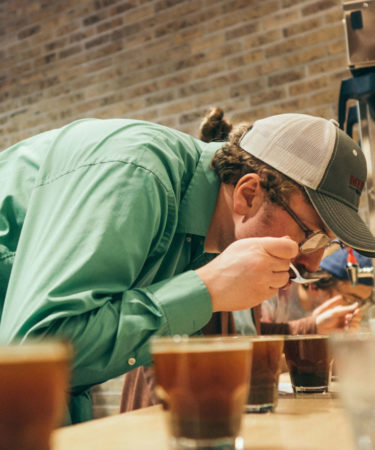For wine enthusiasts, it’s a familiar scene: A group of people take considered, noisy slurps of their drink before spitting into a bucket, writing a few notes, and repeating. Only this tasting isn’t taking place at a winery, it’s a cafe. And the beverage is caffeinated, not alcoholic. Welcome to the world of coffee cupping.
Cupping is how people in the coffee industry evaluate quality and analyze different beans and roasts. Thanks to rising craft coffee culture and general consumer interest, many coffee houses invite enthusiasts to get in on the action as well. VinePair caught up with Sam Sabori, the roasting manager and head of national quality control at Intelligentsia Coffee, to better understand the practice. Sabori has 10 years’ coffee tasting experience and performs cuppings multiple times a day at Intelligentsia’s quality control and roasting departments.
Anyone can carry out a cupping session, he says. “All you really need is a cup, some coffee, and water. There’s no filter required and the only way to mess it up is to let the coffee get too cold.”
Don't Miss A Drop
Get the latest in beer, wine, and cocktail culture sent straight to your inbox.The first step is to grind the beans to a medium grind, slightly coarser than is typically used for a French press. (“If you see large particles, you need to go a little finer,” Sabori says.) Then, you add a predetermined amount to each cup. Next, pour over a measure of hot water, mix, wait to cool, and taste. It’s that easy.
Recipes vary slightly among cafes and roasters. Intelligentsia starts by putting 11 grams of ground coffee in a cup that fits three-quarters of a cup of water. The ideal coffee to water ratio is between 1 to 16 and 1 to 18, Sabori says, and the perfect water temperature is 205 or 206 degrees Fahrenheit.
When you pour the water, a crest will form at the top, with some grounds starting to float. After a four-minute wait, tasters should agitate the grounds and skim off any skin and residual grounds at the surface, then wait another 15 minutes for the coffee to become cool enough to taste. “If you’re tasting it too soon all you’re really tasting is hot coffee,” he says.
When it’s cool, use a spoon to scoop out a sample, being careful not to agitate the grounds settled on the bottom. Some people use special cupping spoons, while others opt to use two spoons — one that goes into the cup and one that goes into the mouth. “Between each sample, we clean our spoons to avoid cross-contamination,” Sabori says.
Just like wine tasting, tasters slurp and spray the coffee around their mouths so the liquid reaches every part of the palate, before spitting into a bucket. “I’m always of the mind that you should spit everything out, even if it tastes great,” Sabori says. “I think there’s a time to enjoy the coffee — after the cupping — but if you start you start drinking all that coffee you can get the jitters pretty quick.”
Tasters grade coffee using a 100-point scale. “First we’re evaluating to see if there are any negatives like insect damage or astringency,” Sabori explains. While tannins might be a good thing in wine, in coffee, astringency indicates the presence of underripe or lesser-quality beans.
“We’re also looking at how sweet it is and we test the acidic structure for citric, malic, and tartaric acids,” he says. As for flavors, fruit notes are the indication of a good coffee — the more complex the better. “In a lot of the higher-scoring coffees, the sweetness is there but it doesn’t get in the way of the fruit notes coming out,” Sabori says.
For inexperienced tasters, tasting this way might reveal unfamiliar flavors. Many first-timers are reminded of drinking black tea. “It’s a phrase we often hear, but that’s really just because the coffee is so far away from what they’re used to, which is commodity- level coffee,” Sabori says.
Fortunately, it’s easy to develop your palate. The fundamental concept of coffee tasting is that sweetness is good, and bitterness is bad. “As long as you can tell between those two things, the rest of it is just exploratory,” Sabori says.
When you do become more experienced, you might start to look at how coffee evolves as it cools. “You will see a noticeable change in the structure and the intensity — those are indicators of quality,” Sabori says. “Those are things that initially inspired me to get into coffee and they’ve kept me around for 10 years.”
For those looking to begin their own coffee-cupping journey, Sabori says it’s as easy as calling up a cafe and asking: “Do you perform public cuppings?” If they do, more often than not, they will be free and guided by a coffee professional.
“Just grab a spoon and have fun,” Sabori says. “And don’t be afraid of the slurp!”
